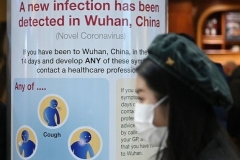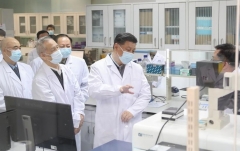
A public health warning sign in London’s Heathrow Airport on January 28, 2020. (Photo by Daniel Leal-Olivas/AFP via Getty Images)
(CNSNews.com) – One hundred and forty-three day since World Health Organization member-states passed a resolution calling for the WHO to work with other agencies to identify how the coronavirus that emerged in Wuhan was able to jump from animals to humans, China has yet to agree upon an international team of experts to visit China to carry out that crucial work.
A top WHO official told a meeting of the agency’s executive board in Geneva this week that WHO had compiled a list of candidates for the international mission and “submitted [it] to Chinese authorities for their consideration and for next steps in order to deploy that team.”
Resolution WHA73.1, passed at a WHO World Health Assembly on May 19, calls on WHO, the World Organization for Animal Health (OIE), and the Food and Agricultural Organization (FAO) to work jointly to “identify the zoonotic source of the virus and the route of introduction to the human population,” and refers specifically to “scientific and collaborative field missions” as part of that effort.
WHO Director-General Tedros Adhanom Ghebreyesus said at the time the inquiry would begin its work “at the earliest time possible.”
Weeks later, Tedros told a briefing, “WHO has been saying that knowing the source of the virus is very, very important,” adding, “we can fight the virus better when we know everything about the virus, including how it started.”
Despite the expressed urgency, more than seven weeks passed after the resolution was adopted before two WHO experts arrived in China in mid-July for a three-week “pre-mission” visit to “develop the scope and terms of reference for a WHO-led international mission.”
After they left the country on August 2, Tedros said in Geneva that they had “concluded their mission to lay the groundwork for further joint efforts to identify the virus origins.”
“As a result of these efforts, WHO and Chinese experts have drafted the terms of reference for the studies and program of work for an international team, led by WHO,” he said. “The international team will include leading scientists and researchers from China and around the world. Epidemiological studies will begin in Wuhan to identify the potential source of infection of the early cases.”

The Wuhan Institute of Virology in Wuhan, the Chinese city where the coronavirus outbreak emerged late last year. (Photo by Hector Retamal/AFP via Getty Images)
Yet since that two-person advance team left China, another 68 days have passed and there is still no indication when the full team will be able to visit the outbreak epicenter.
Over the almost five months since the resolution was passed on May 19, the number of confirmed COVID-19 cases reported around the world has soared from fewer than five million to more than 36 million, and the number of deaths has climbed from around 319,000 to more than 1.05 million.
Five days after the resolution was passed, Chinese Foreign Minister Wang Yi said Beijing was “open to working with the international scientific community to look into the source of the virus,” but insisted that the process be “free of political interference, respect the sovereignty of all countries, and oppose any presumption of guilt.”
‘Critical importance’
CNSNews.com this week sent questions to WHO:
–What progress has been made in preparing for the “international team” to carry out its WHA73.1 mandate to “identify the zoonotic source”?
–Given Dr Tedros’ comment last May about the inquiry beginning “at the earliest time possible,” are there obstacles holding up the process, and if so, can you elaborate?
–When does WHO anticipate the international team will be able to travel to China?
–What level of access does WHO expect the Chinese authorities to allow the experts?
WHO’s media office did not directly answer, but pointed to a presentation provided by Michael Ryan, director of WHO’s emergencies program, at the executive board meeting this week.
Ryan spoke over a series of presentation slides, one of which recalled that as early as February 11-12, a WHO forum had recognized the “critical importance” of understanding the zoonotic sources of the coronavirus.
“This area of animal-human interface was raised at that meeting in February on research priorities,” Ryan said. “It was highlighted in the [May] resolution, and WHO has worked very closely with Chinese authorities by sending an advance team to prepare for those studies. And a pre-mission, as I said, was launched in July. And terms of reference was agreed there in terms of looking at the studies that have already been conducted, identifying gaps in knowledge, and developing terms of reference for both short- and long-term studies in two phases.”
“At the moment WHO has prepared a list of candidates to join such an international mission from all around the world,” he said. “A list of candidates has been submitted to Chinese authorities for their consideration and for next steps in order to deploy that team.”
According to Ryan’s presentation, a short-term phase one study would include “studies of first notified cases in Wuhan.” Then a longer-term, phase two study would include “in-depth epidemiologic, virologic, serologic assessments in humans and animal populations in specific geographic areas or settings as informed by the short-term studies.”
‘Accurate, complete, and timely information’
Resolution WHA73.1 states that establishing the origins of the coronavirus “will enable targeted interventions and a research agenda to reduce the risk of similar events occurring, as well as to provide guidance on how to prevent infection … as well as to reduce further risks of emergence and transmission of zoonotic diseases.”

Chinese President Xi Jinping visits the Academy of Military Medical Sciences in Beijing in March. (Photo: Xinhua/Ding Haitao)
At Monday’s executive board meeting U.S. Assistant Secretary for Health Adm. Brett Giroir, taking part via video link, raised the zoonotic investigation.
“A key mandate from WHA73.1 is the mission WHO, FAO and OIE are leading to identify the zoonotic source of the virus and the route of introduction to the human population,” he said. “As this work was mandated by all member-states, it is critical that all member-states receive regular and timely updates, including the terms of reference for this panel or for any field missions, so that we can all engage with the process and be confident in the outcomes.”
Giroir – without naming any country – said, “we cannot overcome the failure of any member-state to provide accurate, complete, and timely information on outbreaks and potential health emergencies.”
China’s foot-dragging in allowing foreign experts to visit early this year was one of several issues that prompted President Trump to accuse the WHO of being beholden to China, and subsequently signal plans to withdraw from the agency.
Amid delays in determining exactly how, when, and where the coronavirus spread from animals (conceivably bats) to humans, probably via an intermediate host, speculation and theories continue to circulate.
While dealing with infections and trying to stop the spread, along with a hunt for a safe and effective vaccine, are obviously top priorities globally, establishing the origin is important – not so much to apportion blame as to try to prevent future such outbreaks.
“Whether it originated from a wild exposure, food market, or lab is really inconsequential for how we treat and try to put an end to the pandemic,” Baylor College of Medicine metagenomics expert Joseph Petrosino told Genetic Engineering & Biotechnology News last month. “But it’s important from an origin story perspective, so we can try to stop these things from happening in the future.”






